Google Analytics is a free tool to measure your website's traffic. It shows how people find and use your site, helping you improve your marketing efforts.
Setting up Google Analytics is easy.
First, make an account. Then, add a small piece of code to your website to track how people use your site.
In GA4, you'll find charts and numbers that display various metrics, such as the number of website visitors, the most viewed pages, and the average time users spend on the site. These insights provide valuable information about user behavior and engagement.
You can see where visitors come from. For example, from search engines like Google. Or from social media like Facebook. Knowing this helps you advertise better.
In marketing, Google Analytics also tracks visitor actions, such as email sign-ups and purchases. This data helps you measure the effectiveness of your strategies.
Google Analytics takes time to learn but provides valuable marketing insights. Stick with it to maximize online efforts.
Read on to learn more about Google Analytics for marketing insights.
What is GA4?
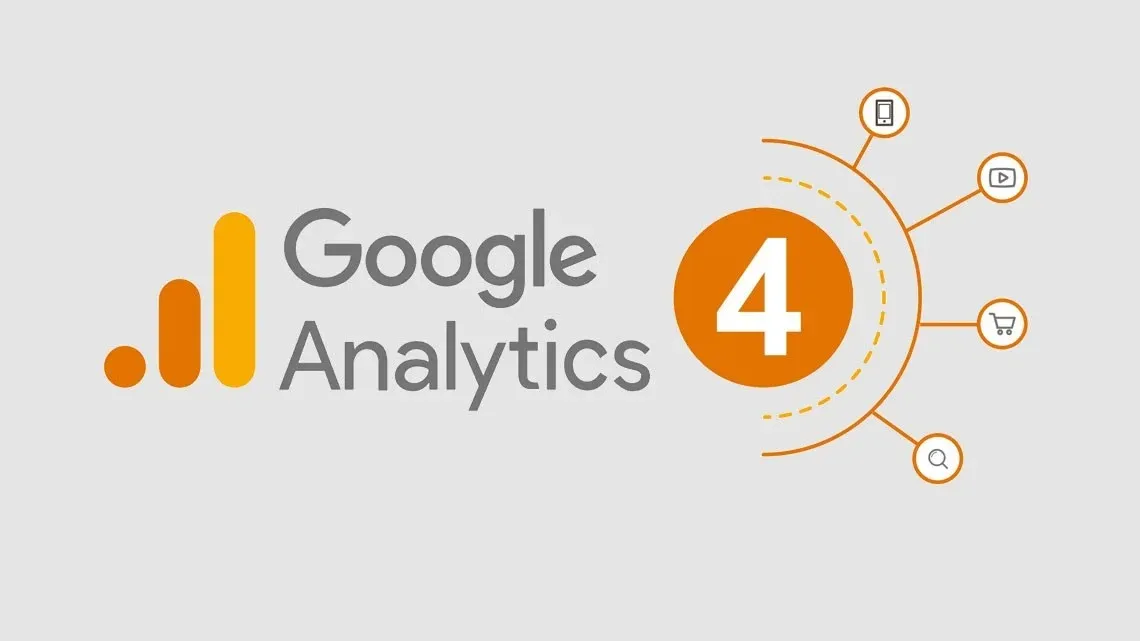
GA4 is the latest version of Google Analytics, featuring a revamped user interface and upgraded reports, tools, and features.
It's designed to provide a more advanced and comprehensive approach to analytics, offering improved insights and capabilities for businesses and marketers.
If you created a Google Analytics account after October 2020, it's likely that you have GA4.
You can distinguish between Universal Analytics and GA4 by the appearance of the home screen, with Universal Analytics on the left and GA4 on the right.
Setting Up Google Analytics
Setting up Google Analytics for marketing is the first step in harnessing its power for marketing insights.
To get started, create a Google Analytics account by visiting the Google Analytics website. Once you create your account, you will receive a unique tracking code. Install this code on every website page to start tracking user data.
The next step is navigating the Google Analytics dashboard.
Navigating the Google Analytics Dashboard
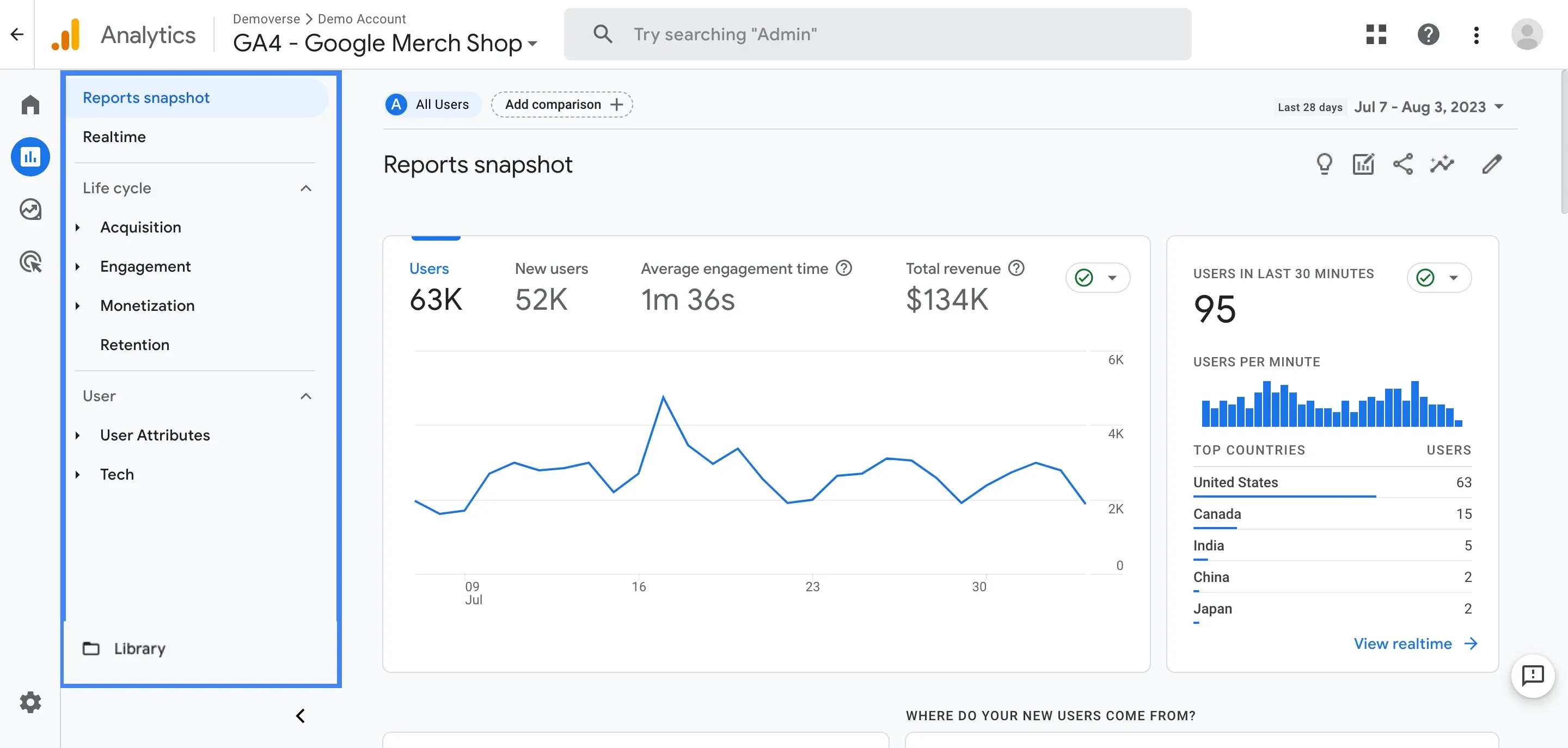
After you create an account and install the tracking code, you can access the Google Analytics dashboard.
The dashboard provides an overview of your website's performance and metrics, allowing you to assess key dimensions quickly.
Key Metrics and Dimensions
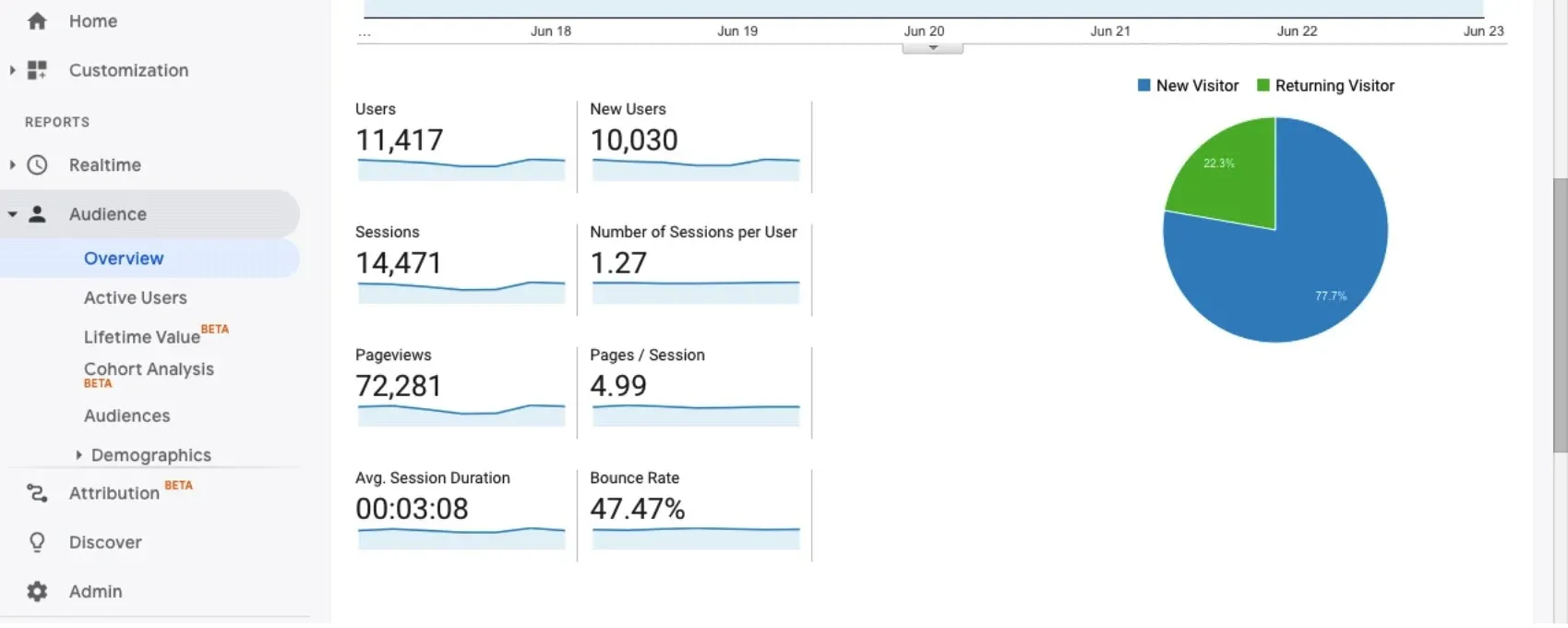
Key metrics in Google Analytics give you insights into your website's performance.
Sessions track the number of visits to your site, users represent unique visitors, pageviews indicate how many pages are viewed, bounce rate measures how many visitors left your site after viewing just one page, and conversion rate represents the percentage of users who complete a desired action.
Sessions
A session is a single visit to your website by a user. Sessions track visitor behavior and can help you understand how users interact with your website.
Users
Users represent the number of unique visitors to your website. By tracking users, you can gain insights into how many people are interested in your content, product, or service.
Pageviews
Pageviews represent the total number of pages viewed on your website. You can use this metric to understand which pages are popular and engaging with your audience.
Engagement Rate
The engagement rate is the percentage of users interacting with your site after viewing one page. This metric can help you identify the level of user involvement on your website, such as content or user experience.
Conversion Rate
The conversion rate is the number of users who complete a specific goal, such as making a purchase or filling out a form, divided by the total number of sessions. This metric allows you to measure the success of your website and marketing campaigns.
Now we will see the reports in Google Analytics for marketing.
Key Reports in Google Analytics
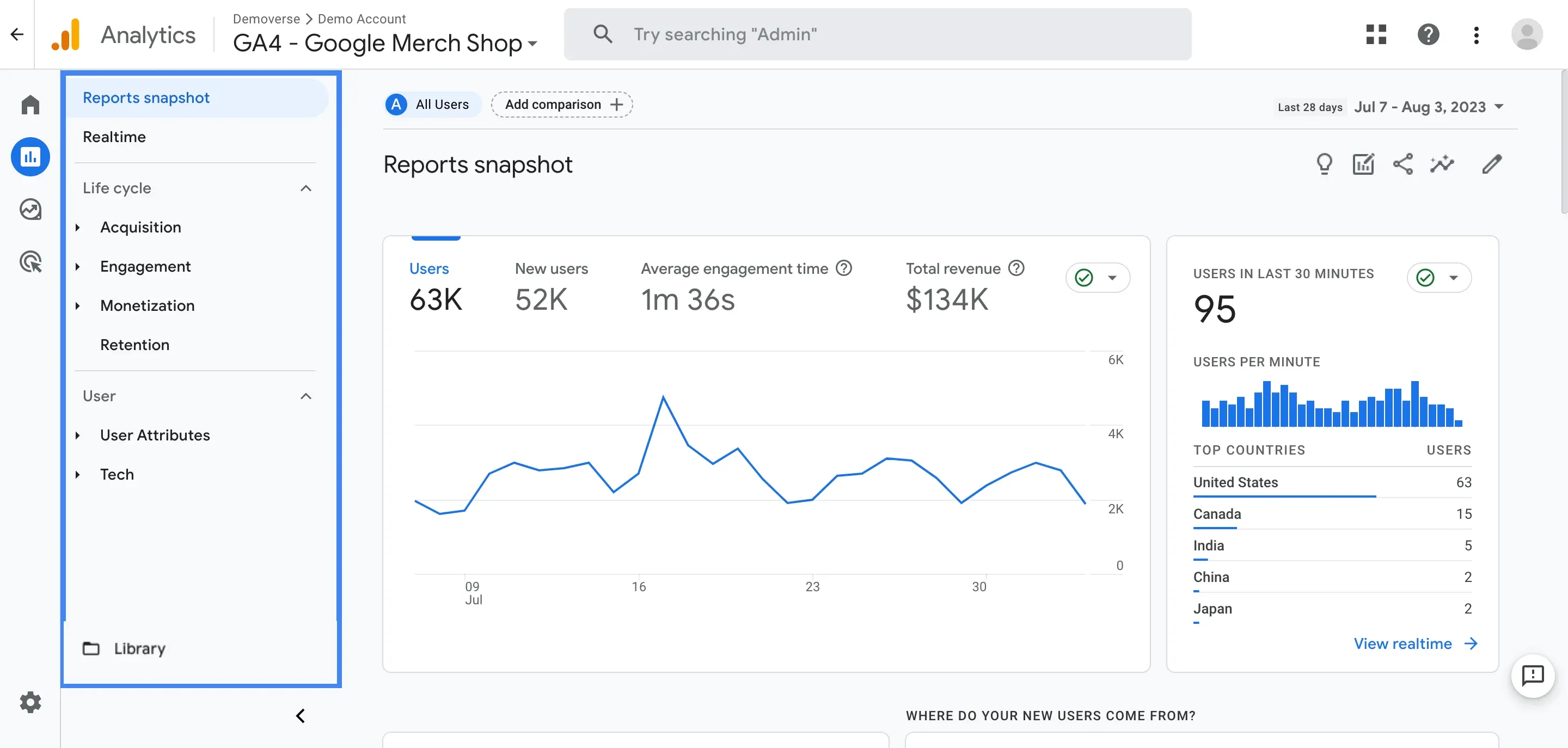
Google Analytics equips you with powerful data to optimize your website. Dive into key reports revealing who your visitors are, how they find you, what they do on your site, and if they convert.
Pinpoint exactly how to tailor marketing to your audience, boost acquisitions, improve user experience, and increase conversions. Let data guide your strategy and growth.
Audience Reports
The audience reports in Google Analytics provide valuable information about your website visitors. This includes demographics such as age, gender, location, interests, and behavior.
Understanding your target audience can tailor your marketing efforts to reach and engage them effectively.
Acquisition Reports
Acquisition reports give you insights into how visitors find your website. Key information includes the channels users use at your site: organic search, paid search, referral traffic, direct traffic, and social media.
Analyzing acquisition data can help you evaluate the success of your marketing channels and make data-driven decisions to optimize your marketing budget.
Behavior Reports
Behavior reports reveal how users interact with your website. You can gain insights into the most popular pages on your site, engagement metrics like time spent on the page and bounce rate, and even how users interact with your site search.
This information helps you identify areas for improvement and optimize the user experience on your website.
Conversion Reports
Conversion reports are instrumental in tracking and measuring the success of your marketing efforts. By setting up goals within Google Analytics, you can track user actions on your website, such as completing a purchase, submitting a form, or signing up for a newsletter.
Conversion reports allow you to measure the effectiveness of your marketing campaigns and identify improvement areas in your conversion funnel.
Now, we will see some advanced features of Google Analytics for marketing, but before that see the latest version of Google Analytics.
Suggested Reading:
Choosing the Right Marketing Analytics Tools for Your Business
Advanced Features of Google Analytics
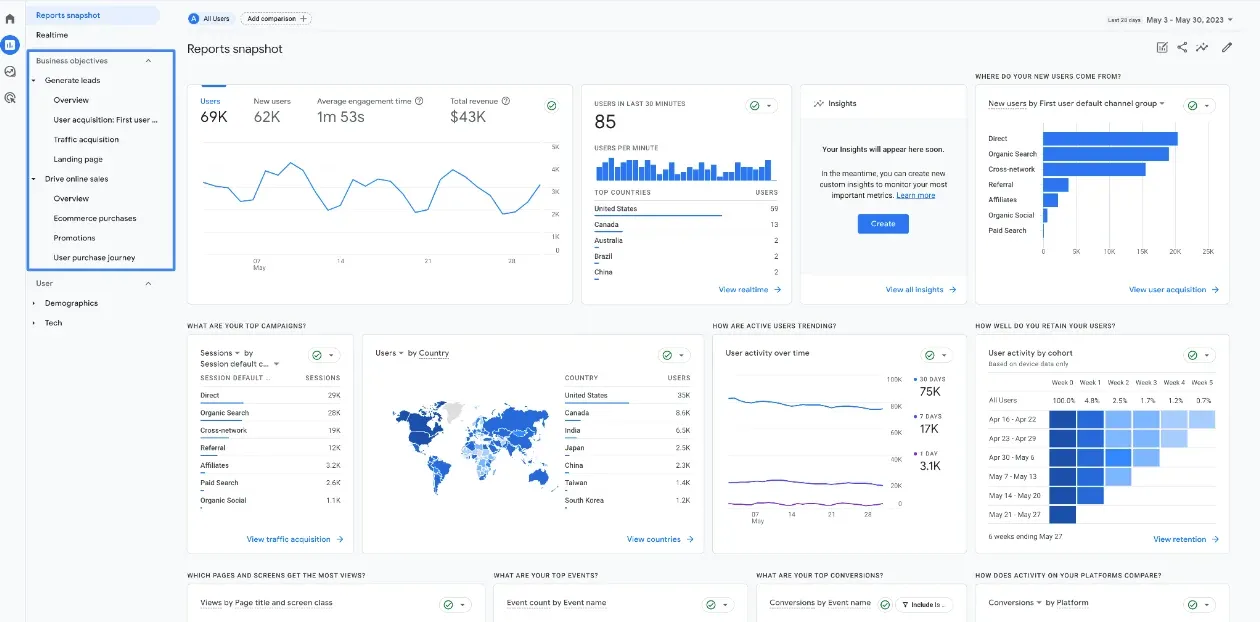
Google Analytics 4 (GA4) offers a range of advanced features that can further enhance your understanding of user behavior and optimize your marketing strategies.
Custom Reports
Custom reports allow you to create tailored reports that focus on specific dimensions and metrics relevant to your business goals.
By applying filters and segments, you can refine your data analysis and gain deeper insights into specific aspects of your website's performance.
Campaign Tracking
Campaign tracking in GA4 allows you to track the effectiveness of your marketing campaigns.
By appending campaign parameters to your campaign URLs, you can easily differentiate and analyze the traffic generated by each marketing campaign.
This helps you measure the ROI of your campaigns and optimize your marketing efforts.
Event Tracking
Event tracking is a powerful feature that lets you track specific user interactions on your website, such as clicks, downloads, video plays, and more.
By setting up event tracking, you can gain insights into user engagement and behavior beyond the standard metrics.
Now, we will see how to use Google Analytics for marketing insight.
Suggested Reading:
Using Google Analytics for Marketing Insights
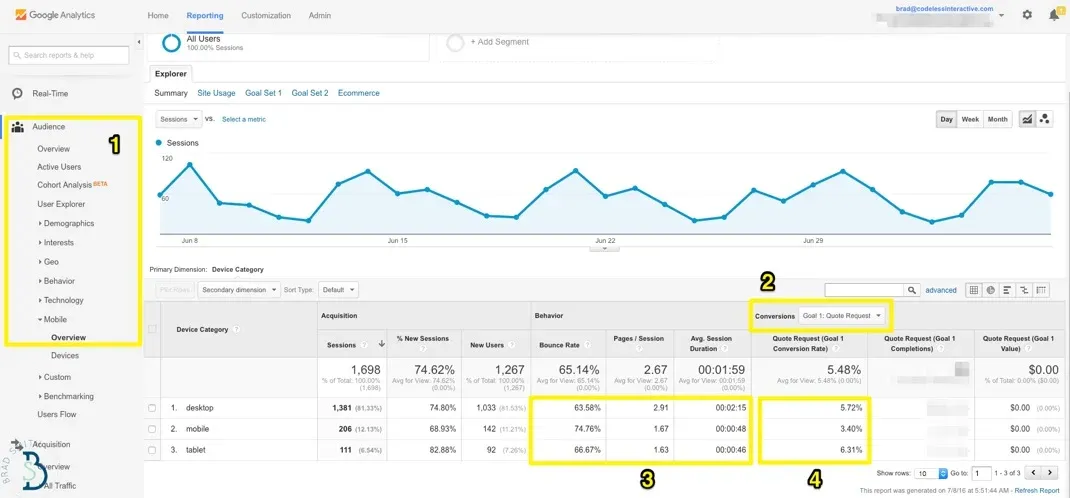
With a solid understanding of the key features and reports in Google Analytics, you can now use this tool to gain valuable marketing insights.
Measuring Website Performance
Google Analytics provides a wealth of data to analyze and measure the performance of your website.
By focusing on key metrics such as traffic sources, landing page performance, and user engagement, you can identify areas for improvement and optimize your website for better marketing outcomes.
Optimizing Marketing Campaigns
By analyzing data from GA4, you can assess the effectiveness of your marketing campaigns and make data-driven decisions to optimize their performance.
You can identify underperforming channels, test different landing pages, and refine your targeting to achieve better results and maximize your return on investment.
The next section will show you some best practices for using Google Analytics for marketing.
Best Practices for Using Google Analytics
To make the most of Google Analytics, it is important to follow best practices that ensure accurate data collection and interpretation.
Set Measurable Goals - Before starting, identify the key goals you want Google Analytics to help you track and measure. This could be anything from increasing website traffic to boosting sales. Be specific and clear about your goals to help focus your analysis.
Define a Conversion - It’s important to define what counts as a conversion for your website and set up conversion tracking in Google Analytics. This will allow you to track how well your website meets its goals, whether from submissions, clicks, downloads, or sales.
Use Filters to Get Accurate Data - Filters in Google Analytics allow you to exclude irrelevant traffic to get accurate data. Set up filters to exclude internal traffic, bot spam, or traffic from specific geographic locations.
Understand Attribution Models - Attribution modeling is used in Google Analytics to track how a conversion is attributed to different touchpoints in the user's journey. Understand how different attribution models work and choose the one that best suits your business.
Use Advanced Segmentation - Segmenting your data can provide deeper insights into user behavior. Use advanced segmentation to group visitors based on various criteria, such as demographics, geography, or behavior.
Track Site Search - Enable site search tracking to see what visitors are searching for on your site. This can help you identify what content or products are in high demand and improve the user experience.
Monitor Site Speed - Site speed is important for user experience, search ranking, and conversion rates. Monitor site speed in Google Analytics and identify ways to improve it.
Regularly Review Reports - Set up regular reports and dashboards to monitor key metrics and dimensions important to your business goals.
Stay Up-to-Date on New Features - Google Analytics regularly releases new features and updates, so stay up-to-date with changes and new functionality to get the most out of the platform.
Conclusion
Learn how to improve your website with Google Analytics. This simple tool shows how people use your site.
See numbers like visitors and pages viewed. Charts show where people come from and what they do. Find out what pages and ads bring in the most people.
Measure important actions, like signups. Analytics shows how well your site meets goals.
Filter the data to see real results. Understand how visits and sales connect. Learn which areas need work.
Keep tabs on speed and search terms. See what people want most.
Regular reviews help. New features come often. Stay updated to get the full picture.
Analytics provides key insights. Use it to strengthen your website and marketing.
Suggested Reading:
Frequently Asked Questions (FAQs)
How do you set up Google Analytics for your website?
To set up Google Analytics for marketing, create an account on their website, obtain a tracking code, and install it on your website's pages.
Which reports should you focus on in Google Analytics?
Pay attention to the Audience, Acquisition, Behavior, and Conversion reports, as they provide valuable insights into your website's performance and user behavior.
Can you track the effectiveness of your marketing campaigns in Google Analytics?
Yes, Google Analytics for marketing offers campaign tracking by adding specific parameters to your URLs. This allows you to measure the ROI of your marketing efforts and optimize your campaigns.
How can Google Analytics help me optimize your marketing campaigns?
By analyzing data from Google Analytics, you can identify underperforming channels, refine targeting, and test different landing pages, improving marketing campaign performance.
What are some common issues with Google Analytics data and how can you troubleshoot them?
Common issues can arise in data accuracy and discrepancies. Understanding and troubleshooting these issues is important by following best practices, checking tracking codes, and regularly reviewing and analyzing data for consistency with Google Analytics for marketing.

